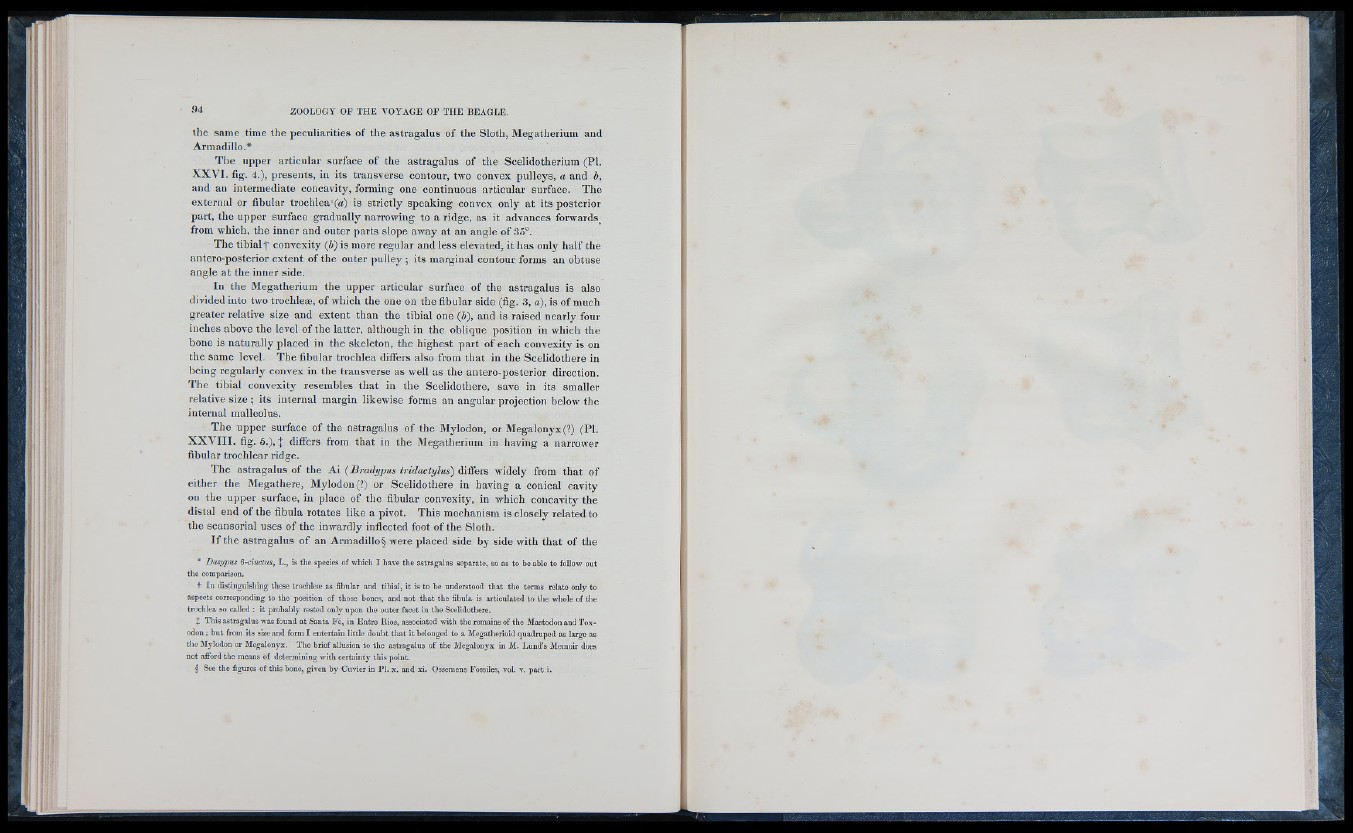
the same time the peculiarities o f the astragalus o f the Sloth, Megatherium and
Armadillo.*
The upper articular surface o f the astragalus o f the Scelidotherium (PI.
X X V I . fig. 4.), presents, in its transverse contour, two convex p ulleys, a and h,
and an intermediate concavity, forming one continuous articular surface. The
external or fibular trochlea’(a) is strictly speaking convex only at its posterior
part, the upper surface gradually narrowing to a ridge, as it advances forwards
from which, the inner and outer parts slope away at an angle o f 3 5 °.
The tib ia lf convexity (A) is more regular and le ss elevated, it has only ha lf the
antero-posterior extent o f the outer pulley ; its marginal contour forms an obtuse
angle at the inner side.
In the Megatherium the upper articular surface o f the astragalus is also
divided into two trochleae, o f which the one on the fibular side (fig. 3, a), is o f much
greater relative size and extent than the tibial one (A), and is raised nearly four
inches above the level o f the latter, although in the oblique position in which the
hone is naturally placed in the skeleton, the highest part o f each convexity is on
the same level. The fibular trochlea differs also from that in the Scelidothere in
being regularly convex in the transverse as well as the antero-posterior direction.
Th e tibial convexity resembles that in the Scelidothere, save in its smaller
relative s i z e ; its internal margin likewise forms an angular projection below the
internal malleolus.
The upper surface o f the astragalus o f the Mylodon, or Megalonyx (?) (PI,
X X V I I I . fig. 5.), :J; differs from that in the Megatherium in having a narrower
fibular trochlear ridge.
The astragalus o f the A i {Bradypus tridactylus) differs widely from that of
either the Megathere, Mylodon (?) or Scelidothere in having a conical cavity
on the upper surface, in place o f the fibular convexity, in which concavity the
distal end o f the fibula rotates like a pivot. This mechanism is c lose ly related to
tlie scansorial use s o f the inwardly inflected foot o f the Sloth.
I f the astragalus o f an Armadillo^ were placed side by side with that o f the
* Dasypus Q-cinctus, L., is the species of which I hare the astragalus separate, so as to be able to follow out
the comparison.
+ In distinguishing these trochle® as fibular and tibial, it is to he understood that the terms relate only to
aspects corresponding to the position of those bones, and not that the fibula is articulated to the whole of the
trochlea so called : it probably rested only upon the outer facet in the Scelidothere.
X This astragalus was found a t Santa Fe, in Entre Rios, associated with the remains of the Mastodon and Toxodon
; but from its size and form I entertain little doubt th at it belonged to a Megatherioid quadruped as large as
tlie Jlylodon or Megalonyx. The brief allusion to the astragalus of the Megalonyx in M. Lund’s Memoir does
not afford the means of determining with certainty this point.
§ See the figures of this hone, given by Cuvier in PI, x. and xi. Ossemens Fossiles, vol. v. part i.